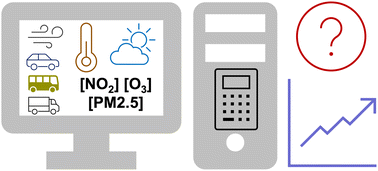Application of machine learning and statistical modeling to identify sources of air pollutant levels in Kitchener, Ontario, Canada†
Abstract
Machine learning is used across many disciplines to identify complex relations between outcomes and numerous potential predictors. In the case of air quality research in heavily populated urban centers, such techniques were used to correlate the impacts of Traffic-Related Air Pollutants (TRAP) on vulnerable members of communities, future pollutant levels, and potential solutions that mitigate adverse effects of poor air quality. However, machine learning tools have not been used to assess the variables that influence measured pollutant levels in a suburban environment. The objective of this study is to apply a novel combination of Random Forest (RF) modeling, a machine learning algorithm, and statistical significance analysis to assess the impacts of anthropogenic and meteorological variables on observed pollutant levels in two separate datasets collected during and after the COVID-19 lockdowns in Kitchener, Ontario, Canada. The results highlight that TRAP levels studied here are linked to meteorology and traffic count/type, with relatively higher sensitivity to the former. Upon taking statistical significance into account when assessing relative importance of variables affecting pollutant levels, our study found that traffic variables had a more discernible influence than many meteorological variables. Additional studies with a larger dataset and spread throughout the year are needed to expand upon these initial findings. The proposed approach outlines a “blueprint” method of quantifying the importance of traffic in mid-size cities experiencing fast population growth and development.

- This article is part of the themed collections: The Use of Machine Learning in Atmospheric Science Research - Topic Highlight and A collection on dense networks and low-cost sensors, including work presented at ASIC 2022


 Please wait while we load your content...
Please wait while we load your content...